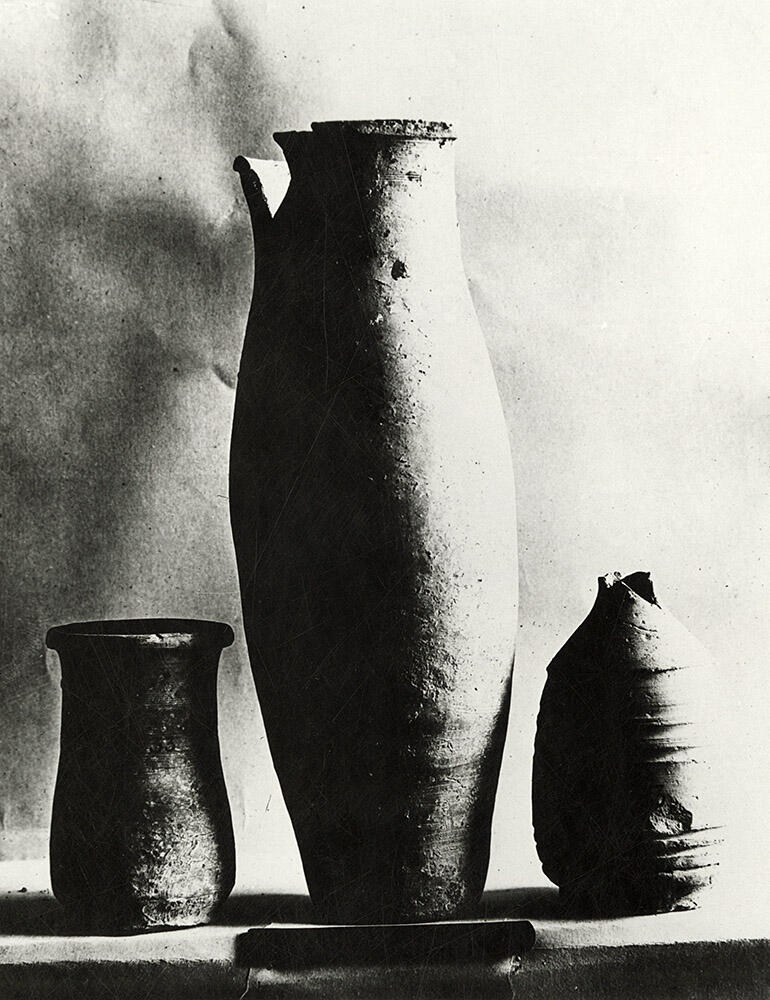On the left is the crucible, or container, apparently found in the large earthen chati. The central object is described as a water-jug, and on the left a bottle, among many pottery objects found during those first excavations in Trench A of Mound F and, in more than one case, within a larger terracotta container.
"The excavations were fruitful in bringing to light an interesting collection of earthenware objects of a pre-historic date which may be classified under' the following heads:—
(1) Vessels of ordinary domestic use all turned on the wheel
(2) Terracotta objects consisting of figurines of men, animals,etc.
(3) Ornaments.
"The pottery found at Harappa is of the light red or brown colour, excepting some specimens which are black. The latter colour is produced by the application of a variety of earth after it has been fired once. The pottery is put back into the kiln again and taken out when the kiln is cool. The decoration of the wares is in most cases of the simplest description, and consists of a few lines cut into the body when the vessel is being moulded on the potter’s wheel. In some cases black lines are smeared on the vessels before they are baked. The material for the pottery must have been easily available from the coarse alluvial clay from the bank of the river Ravi, which formerly flowed quite close to the ancient city, and fine sand from its bed. All pottery found at Harappa is unglazed, and not a single piece of glazed pottery was noticed during the excavations. Red ochre or geru appears on a few fragments, while one fragment (A 198) is decorated with a labyrinth of circles and an ornament resembling the Greek fret both in black colour. A few specimens of the earthen mallet, which is used to this day tor tapping the vessels after their removal from the wheel, were found. Some of the forms of the pottery are simple, but pleasing. Some of these vessels closely resemble in shape the pre-historic pottery from Tinnevelly. The domestic vessels are of the following kinds :—
"(1) Large, grain or water jars or chatis. No small pitchers or gharas or surahis were found. These chatis are of the oval or egg-shaped form with narrow, circular bottoms and broad mouths with stout rims. (A 233.)"
- Daya Ram Sahni, Annual Progress Report of the Archaeological Survey [of India], Hindu and Buddhist Monuments, Northern Circle for the Year Ending 31st March 1921, p. 12.
"The vessel on the left is a flat bottomed cylindrical jar and not a crucible. They appear to have been used for drinking or containing liquids. The taller jar with flaring rim is also for liquids and is similar in size to some of the large drinking vessels used for buttermilk in the Punjab today. The smaller bottle on the right has a very narrow neck but a broken rim. This type of vessel may have been used for dispensing oils. For comparative examples from the HARP excavations see Burial pottery and for the bottle, see Late Harappan pottery."
- Jonathan Mark Kenoyer, 2021.
A. 224 A large water-jug (height 1' 3/4") with a body and flat bottom. (Type 6.) Similar well, preserved specimen in the Lahore Museum. Also among Tinnevelly specimens in the Indian Museum, Calcutta.
A. 233 [Crucible only above] A large chati, plain except for black lines round the body, which was badly cracked, but whose contents were–one crucible (height 4 1/2"), one lota (height 6") with projecting base, one terracotta ram (length 2 1/2"), one earthen bangle, one stone chess figure, a wheel, etc. etc.
A. 3 Earthenware bottle (height 5 1/2") with a broad cylindrical body and a flat bottom but very narrow neck, which is now broken. Incised lines on body. Probably used for keeping oil.
[Appendix D] 2751 An earthenware jar (A 224), A crucible (A233) and a bottle. A3 Earthenware bottle (height 5 1/2") with a broad cylindrical body and a flat bottom but very narrow neck, which is now broken. Incised lines on body. Probably used for keeping oil.

